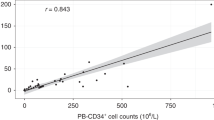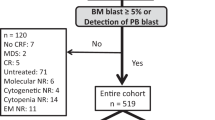Abstract
Fifty-six patients with chemosensitive NHL were studied to assess factors affecting mobilization and peripheral blood stem cell (PBSC) collection: all were mobilized with high-dose cyclophosphamide and etoposide and G-CSF 5 μg/kg/day. None of them had bone marrow involvement at the time of mobilization or a history of extended field irradiation. Previous chemotherapy regimens were divided into two groups: moderately myelotoxic chemotherapy (MMC) and highly myelotoxic chemotherapy (HMC). The adequacy of the PBSC harvest was not associated with age, gender, a past history of bone marrow involvement or disease status. In contrast, the number of MMC cycles (n(MMC)) and the number of HMC cycles (n(HMC)) were both significant (P = 0.009 and P = 0.0004, respectively) and were used to compute a score predictive of a successful PBSC harvest: SCORE = n(MMC) + 4 n(HMC). The estimated successful PBSC collection rate was greater than 80% in patients with a score ranging from 0 to 15 and dropped rapidly to below 20% in patients with a score exceeding 25. This scoring system may help to determine the timing of PBSC mobilization in patients with a score below 15 and suggests that new PBSC mobilization procedures should be investigated in other patients. Bone Marrow Transplantation (2000) 25, 495–499.
This is a preview of subscription content, access via your institution
Access options
Subscribe to this journal
Receive 12 print issues and online access
$259.00 per year
only $21.58 per issue
Buy this article
- Purchase on Springer Link
- Instant access to full article PDF
Prices may be subject to local taxes which are calculated during checkout

Similar content being viewed by others
References
Philip T, Gugliemi C, Hagenbeek A et al. Autologous bone marrow transplantation as compared with salvage chemotherapy in relapses of chemotherapy-sensitive non-Hodgkin's lymphoma New Engl J Med 1995 333: 1540–1545
Gianni AM, Bregni M, Siena S et al. High-dose chemotherapy and autologous bone marrow transplantation compared with MACOP-B in aggressive B-cell lymphoma New Engl J Med 1997 336: 1290–1297
Hartmann O, Le Corroller AG, Blaise D et al. Peripheral blood stem cell and bone marrow transplantation for solid tumors and lymphomas: hematologic recovery and costs. A randomized, controlled trial Ann Intern Med 1997 126: 600–607
Haas R, Möhle R, Frühauf S et al. Patient characteristics associated with successful mobilizing and autografting of peripheral blood progenitor cells in malignant lymphoma Blood 1994 83: 3787–3794
Freedman A, Neuberg D, Mauch P et al. Cyclophosphamide, doxorubicin, vincristine, prednisone dose intensification with granulocyte colony-stimulating factor markedly depletes stem cell reserve for autologous bone marrow transplantation Blood 1997 90: 4996–5001
Haioun C, Lepage E, Gisselbrecht C et al. Benefit of autologous bone marrow transplantation over sequential chemotherapy in poor-risk aggressive non-Hodgkin's lymphoma: updated results of the prospective study LNH87-2. Groupe d'Etude des Lymphomes de l'Adulte J Clin Oncol 1997 15: 1131–1137
Rodriguez MA, Cabanillas FC, Velasquez W et al. Results of a salvage treatment program for relapsing lymphoma: MINE consolidated with ESHAP J Clin Oncol 1995 13: 1734–1741
Solal-Celigny P, Lepage E, Brousse N et al. Recombinant interferon alfa-2b combined with a regimen containing doxorubicin in patients with advanced follicular lymphoma. Groupe d'Etude des Lymphomes de l'Adulte New Engl J Med 1993 329: 1608–1614
Bastion Y, Brice P, Haioun C et al. Intensive therapy with peripheral blood progenitor cell transplantation in 60 patients with poor-prognosis follicular lymphoma Blood 1995 86: 3257–3262
A predictive model for aggressive non-Hodgkin's lymphoma . The International Non-Hodgkin's Lymphoma Prognostic Factors Project New Engl J Med 1993 329: 987–994
Meerwaldt JH, Carde P, Somers R et al. Persistent improved results after adding vincristine and bleomycin to a cyclophosphamide/hydroxorubicin/Vm-26/prednisone combination (CHVmP) in stage III-IV intermediate and high-grade non-Hodgkin's lymphoma Ann Oncol 1997 8: (Suppl. 1) 67–70
Hayat M, Ostronoff M, Gilles E et al. Salvage therapy with methyl-gag, high-dose Ara-C, M-Amsa, and ifosfamide (MAMI) for recurrent or refractory lymphoma Cancer Invest 1990 8: 1–5
Gisselbrecht C . Hematopoietic growth factors in practice: importance and problems Bull Acad Natl Med 1994 178: 791–792
Morel P, Munck JN, Coiffier B et al. A new high-dose CHOP regimen followed by an intensive consolidation in patients aged 60 years with aggressive lymphoma (NHL) presenting with only one adverse prognostic factor of the International Prognostic Index Blood 1997 90: (Suppl. 1) Abstr. 587a
Stamatoullas A, Fruchart C, Bastit D et al. Ifosfamide, etoposide, cytarabine, and methotrexate as salvage chemotherapy in relapsed or refractory aggressive non-Hodgkin's lymphoma Cancer 1996 77: 2302–2307
Hosmer DW, Lameshow S . Applied Logistic Regression Wiley: New York 1989
Harris NL, Jaffe ES, Stein H et al. A revised European-American classification of lymphoid neoplasms: a proposal from the International Lymphoma Study Group Blood 1994 84: 1361–1392
Koumakis G, Vassilomanolakis M, Hatzichristou H et al. Predictive factors affecting mobilization and peripheral blood stem cell (PBSC) collection using single apheresis (SA) for rescuing patients after high-dose chemotherapy (HD.CHE) in various malignancies Bone Marrow Transplant 1996 18: 1065–1072
Drake M, Ranaghan L, Morris TC et al. Analysis of the effect of prior therapy on progenitor cell yield: use of a chemotherapy scoring system Br J Haematol 1997 98: 745–749
Morton J, Morton A, Bird R et al. Predictors for optimal mobilization and subsequent engraftment of peripheral blood progenitor cells following intermediate dose cyclophosphamide and G-CSF Leukemia Res 1997 21: 21–27
Kotasek D, Shepherd KM, Sage RE et al. Factors affecting blood stem cell collections following high-dose cyclophosphamide mobilization in lymphoma, myeloma and solid tumors Bone Marrow Transplant 1992 9: 11–17
Van Os R, Robinson S, Sheridan T et al. Granulocyte colony-stimulating factor enhances bone marrow stem cell damage caused by repeated administration of cytotoxic agents Blood 1998 92: 1950–1956
Hornung RL, Longo DL . Hematopoietic stem cell depletion by restorative growth factor regimens during repeated high-dose cyclophosphamide therapy Blood 1992 80: 77–83
Tjan-Heijnen VC, Biesma B, Festen J et al. Enhanced myelotoxicity due to granulocyte colony-stimulating factor administration until 48 hours before the next chemotherapy course in patients with small-cell lung carcinoma J Clin Oncol 1998 16: 2708–2714
Watts MJ, Sullivan AM, Leverett D et al. Back-up bone marrow is frequently ineffective in patients with poor peripheral-blood stem-cell mobilization J Clin Oncol 1998 16: 1554–1560
Weaver A, Chang J, Wrigley E et al. Randomized comparison of progenitor-cell mobilization using chemotherapy, stem-cell factor, and filgrastim or chemotherapy plus filgrastim alone in patients with ovarian cancer J Clin Oncol 1998 16: 2601–2612
Acknowledgements
We are grateful to Lorna Saint Ange for editing.
Author information
Authors and Affiliations
Rights and permissions
About this article
Cite this article
Vantelon, J., Koscielny, S., Brault, P. et al. Scoring system for the prediction of successful peripheral blood stem cell (PBSC) collection in non-Hodgkin's lymphoma (NHL): application in clinical practice. Bone Marrow Transplant 25, 495–499 (2000). https://doi.org/10.1038/sj.bmt.1702201
Received:
Accepted:
Published:
Issue Date:
DOI: https://doi.org/10.1038/sj.bmt.1702201
Keywords
This article is cited by
-
Stem cell factor and high-dose twice daily filgrastim is an effective strategy for peripheral blood stem cell mobilization in patients with indolent lymphoproliferative disorders previously treated with fludarabine: results of a Phase II study with an historical comparator
Leukemia (2009)
-
Predictive factors for successful stem cell mobilization in patients with indolent lymphoproliferative disorders previously treated with fludarabine
Leukemia (2004)
-
Prediction of mobilisation failure in patients with non-Hodgkin's lymphoma
Bone Marrow Transplantation (2004)
-
Analysis of remobilization success in patients undergoing autologous stem cell transplants who fail an initial mobilization: risk factors, cytokine use and cost
Bone Marrow Transplantation (2004)
-
Is chemotherapy scoring useful to predict progenitor cell mobilisation in patients with non-Hodgkin's lymphoma?
Bone Marrow Transplantation (2003)



